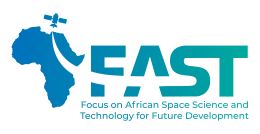As part of the FAST4Future activities for WP7, SANSA hosted a week-long STEM festival during World Space Week, 2-6 October 2023.  The event included four days of activities for learners ranging from primary school to high school, a public lecture, and a workshop for early career scientists on giving lectures to the public or to learners. These events were co-organized by the SANSA Science Engagement team and the FAST4Future team. Approximately 150 learners participated, and the public lecture has been streamed 108 times on youtube.
The event included four days of activities for learners ranging from primary school to high school, a public lecture, and a workshop for early career scientists on giving lectures to the public or to learners. These events were co-organized by the SANSA Science Engagement team and the FAST4Future team. Approximately 150 learners participated, and the public lecture has been streamed 108 times on youtube.
 The student activity events were generally a half day. Beginning with slides and movies about what space weather is and how it affects technology and society, then followed by an informal chat about what it’s like to be a scientist, led by Prof. Martin Snow. Students generally had many questions, ranging from rainbows the power outages. The students then got a tour of the SANSA Space Weather Centre where a Forecaster gave a description of the current conditions
The student activity events were generally a half day. Beginning with slides and movies about what space weather is and how it affects technology and society, then followed by an informal chat about what it’s like to be a scientist, led by Prof. Martin Snow. Students generally had many questions, ranging from rainbows the power outages. The students then got a tour of the SANSA Space Weather Centre where a Forecaster gave a description of the current conditions
The learners then spent a few hours doing hands-on activities: building a model cubesat, using a balloon to propel a vehicle, and building a rocket powered by compressed air.
The primary school learners did an activity on the interior of the Earth rather than building rockets. They coloured in the various layers of the interior: the core, the mantle, and the crust on a flat piece of paper and then turned it into a cross section of the Earth.
The final activity for the learners was to visit the many hands-on exhibits in SANSA’s certified Science Centre. The public engagement activity was a lecture given by Prof. Martin Snow titled “Storms from the Sun: protecting tomorrow’s technology.” It was livestreamed to youtube, and delivered in-person to a crowd of about 50 people in Hermanus. The video recording is available at here.
The final component of our STEM festival was a workshop led by the UK Space Academy for early career scientists. The topic was on how to give science talks to the public. There were tips on making eye contact, choosing accessible language, the speaker’s body language, and timing. The workshop was attended by graduate students, post docs, science support staff, and a few senior scientists.
Overall, the week-long STEM festival was a huge success. More than 150 learners and 100 members of the public were engaged in these activities. The support of the SANSA science engagement team was essential to the success of this festival, and we deeply appreciate their collaboration with FAST4Future.



